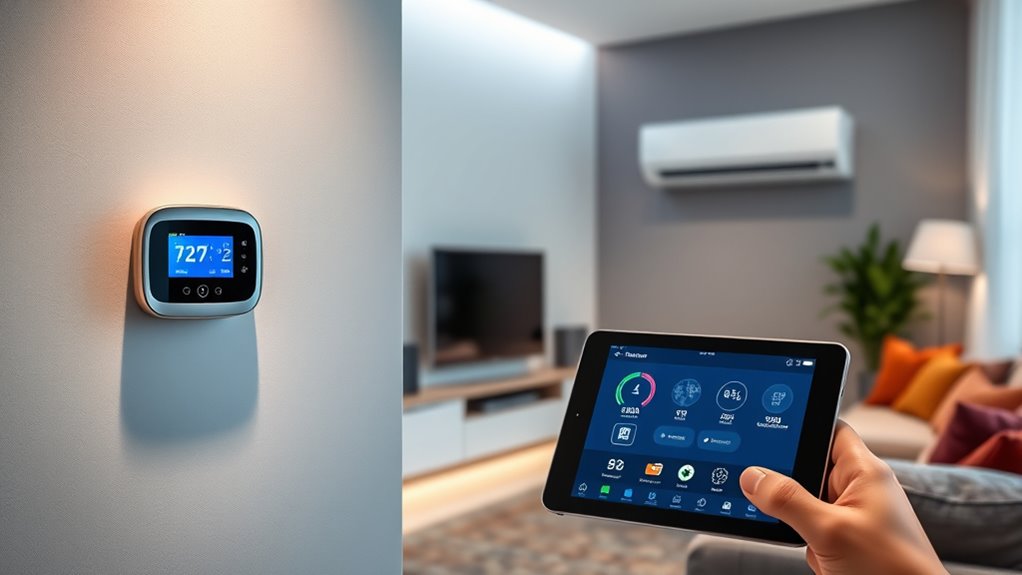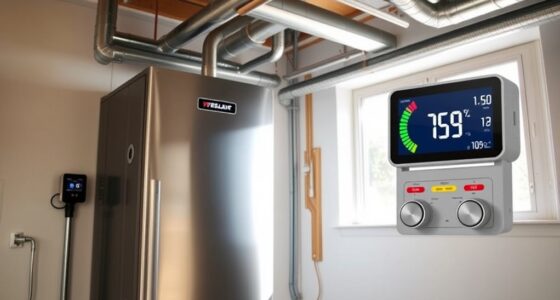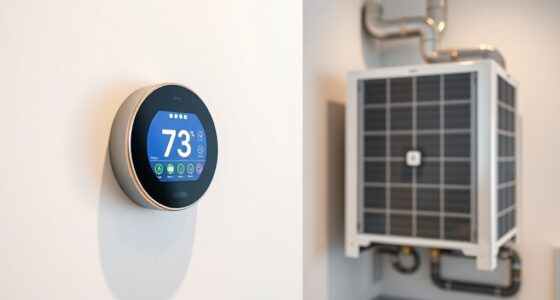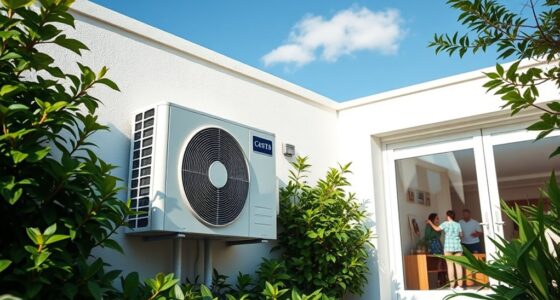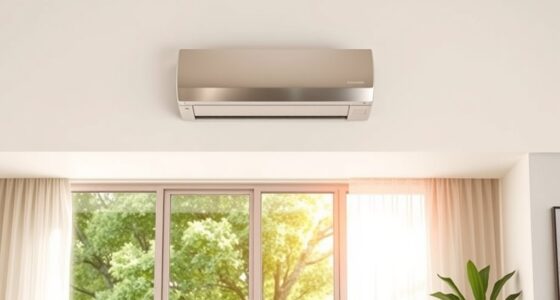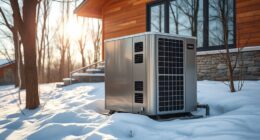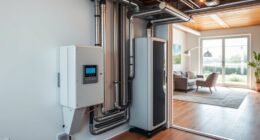Integrating heat pumps with smart home climate control allows you to optimize comfort, save energy, and simplify system management. You can choose compatible smart thermostats that support heat pump-specific features, connect sensors for automation, and set schedules remotely. Proper integration enhances efficiency, reduces costs, and provides seamless control via voice commands or apps. To get the most out of your system and explore advanced options, continue exploring how this technology can work best for you.
Key Takeaways
- Ensure heat pump compatibility with smart thermostats supporting AUX, emergency heat, and multi-stage controls.
- Choose smart thermostats with Wi-Fi, Zigbee, or Z-Wave support for seamless integration.
- Program sensors and automation rules for occupancy-based adjustments and zone-specific climate control.
- Regularly update firmware and run diagnostics to maintain optimal system performance and energy efficiency.
- Utilize AI and advanced algorithms in smart systems to optimize operation, predict maintenance, and maximize energy savings.
Understanding Heat Pumps and Their Types
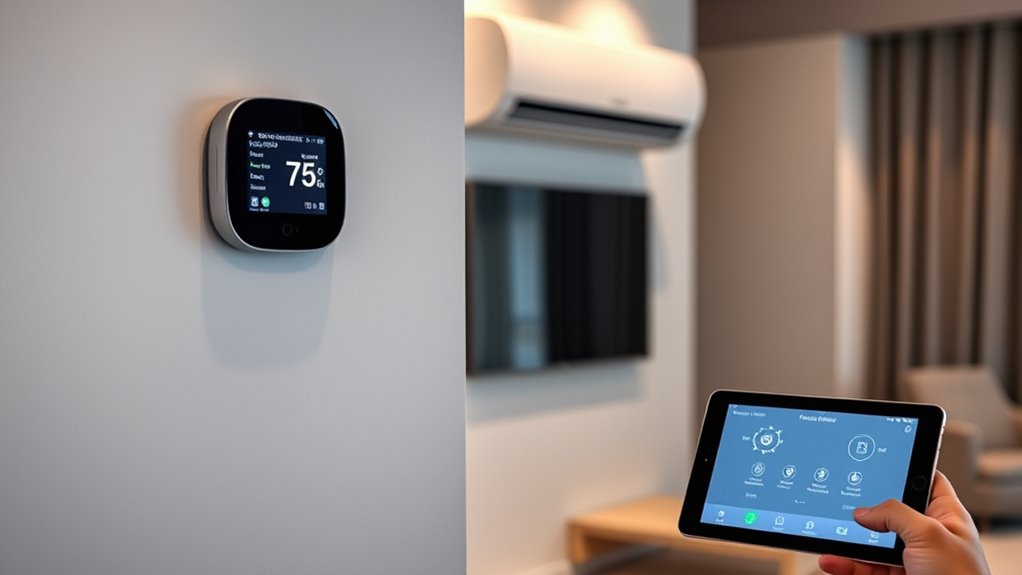
Have you ever wondered how heat pumps efficiently heat and cool your home? Heat pumps are versatile HVAC systems that transfer heat from outside sources into your living space for climate control. There are three main types: air source, geothermal, and water source. Air source heat pumps (ASHPs) extract heat from outdoor air and work well in milder climates, providing both heating and cooling year-round. Geothermal heat pumps (GSHPs) tap into the stable underground temperatures, offering high energy efficiency but with higher installation costs. Water source heat pumps (WSHPs) draw heat from nearby water bodies like lakes or rivers, delivering efficient temperature regulation when water access is available. These systems can seamlessly integrate with smart home automation, enhancing overall energy efficiency and comfort. Proper installation practices are also crucial for designing efficient and effective systems that meet specific climate needs. Additionally, understanding smart technology integration can optimize heat pump performance and energy savings. Ensuring proper system design can maximize the benefits of these technologies and contribute to sustainable living. Incorporating advanced control systems can further enhance operational efficiency and user comfort.
The Advantages of Smart Home Climate Control
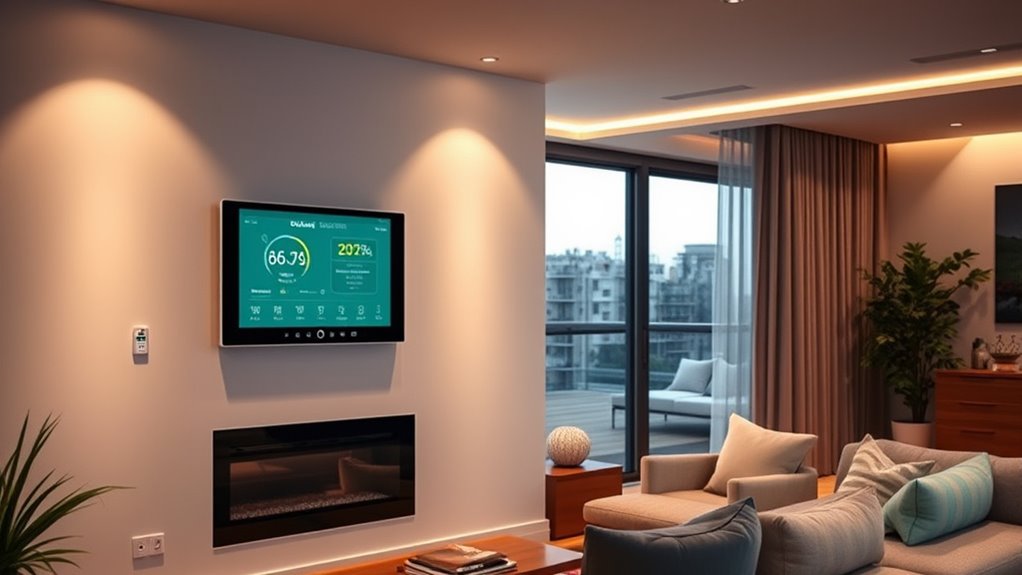
Smart home climate control systems offer significant advantages by making your heating and cooling more efficient and responsive. By integrating heat pumps with smart thermostats, you can achieve better energy efficiency through adaptive scheduling and zoning. These systems learn your preferences, reducing energy waste and lowering utility bills by up to 30%. With remote access, you can adjust your climate settings anytime from your smartphone or voice assistant, ensuring comfort even when you’re away. Occupancy sensors help the system detect when rooms are in use, optimizing indoor air quality and maintaining a healthy environment. Additionally, incorporating natural materials can enhance the overall ambiance and sustainability of your home. Implementing renewable energy solutions like solar-powered systems can further decrease your carbon footprint and increase energy independence. Understanding store hours can also be beneficial for scheduling maintenance or upgrades to your system during convenient times. Modern heat pump technology also benefits from technological advancements, ensuring your system remains efficient and reliable over time. Staying informed about energy efficiency standards can help you select the most eco-friendly options for your home. Overall, smart home climate control enhances energy management and home automation, giving you greater control, convenience, and eco-friendly operation.
Selecting Compatible Smart Thermostats for Heat Pumps
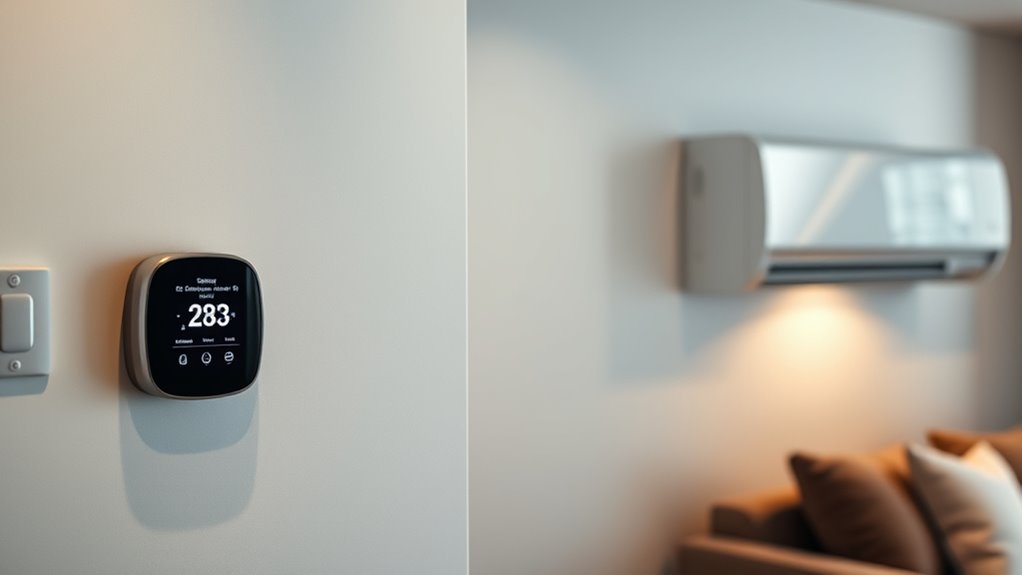
When choosing a smart thermostat for your heat pump, make sure it’s explicitly compatible and supports key features like AUX and emergency heat controls. Check that it connects easily via Wi-Fi, Zigbee, or Z-Wave and can handle multi-stage heating and cooling. Opt for models with advanced algorithms designed to optimize efficiency and simplify installation. Additionally, verify that the thermostat’s privacy policy aligns with your data protection preferences to ensure your personal information remains secure. Confirm that the thermostat can support efficient heat pump operation to maximize energy savings and system longevity. Furthermore, choosing a thermostat that can adapt to AI-driven solutions can enhance overall system performance and comfort. Given the increasing emphasis on sustainability in energy systems, selecting a model with eco-friendly features can also contribute to reducing your carbon footprint. Incorporating AI-based optimization tools can further improve comfort levels and energy management over time.
Compatibility With Heat Pump Models
Selecting a compatible smart thermostat for your heat pump requires verifying that it aligns with your system’s wiring and control setup. Confirm it supports heat pump compatibility and the necessary wiring requirements, like a C-wire for power. Check that the thermostat supports HP control mode to optimize efficiency and prevent short cycling. Verify it can handle auxiliary heat control and offers features like defrost management, essential for proper heat pump operation. Compatibility with your heat pump’s brand and model is critical, as some manufacturers recommend specific thermostats for seamless integration. Additionally, look for support for common communication protocols such as Wi-Fi, Z-Wave, or Zigbee, which facilitate smooth system integration and system optimization. Proper matching guarantees reliable performance and maximizes your heat pump’s efficiency. Smart home integration can further enhance your system’s functionality and user experience, especially when considering security and privacy features to protect your network.
Connectivity Protocols and Features
Selecting a compatible thermostat for your heat pump hinges on ensuring it supports the right connectivity protocols. Wi-Fi, Zigbee, and Z-Wave are common standards that enable seamless integration and reliable communication. Wi-Fi smart thermostats connect directly to your internet, offering remote control via smartphone apps and compatibility with platforms like Alexa and Google Home. Zigbee and Z-Wave protocols provide low-power, stable connections ideal for integrating thermostats within smart home ecosystems, working smoothly with hubs and sensors. When choosing, verify that the thermostat supports your heat pump’s control requirements and communication standards. Modern smart thermostats often include advanced control features, such as system-specific scheduling and automatic optimization, making integration straightforward and enhancing your home climate management. Additionally, understanding Cultural Intelligence can help in selecting systems that are compatible with diverse user preferences and technological standards across different regions. Ensuring the thermostat supports communication standards relevant to your region can improve reliability and user experience, especially when considering regional compatibility for optimal performance. Furthermore, selecting a thermostat that supports interoperability with various devices can enhance your overall smart home ecosystem and flexibility. It is also beneficial to consider energy efficiency features in your selection to maximize savings and environmental benefits.
Installation and Setup Ease
Ensuring your smart thermostat is easy to install and set up can save you time and frustration. Start by choosing a smart thermostat that explicitly supports heat pump integration, with features like heat pump-specific modes and compatibility with your system. Verify it offers Wi-Fi connectivity for remote control and seamless integration into your smart home setup. Check that it’s compatible with your heat pump’s control wiring, such as requiring a C-wire or auxiliary power connection. Look for models with advanced features like dual fuel or AUX heat control to optimize efficiency. For a smooth process, consider professional installation if needed, especially to guarantee proper wiring and setup. Confirm the thermostat’s compatibility with your smart home ecosystem to enjoy reliable operation and easy control. Additionally, understanding heat pump-specific features can help in selecting the most suitable thermostat for optimal climate management. Being aware of smart home ecosystem compatibility can also prevent setup issues and enhance overall system performance. Recognizing installation requirements beforehand ensures a seamless integration process.
Installing and Setting Up Your Smart Heat Pump System
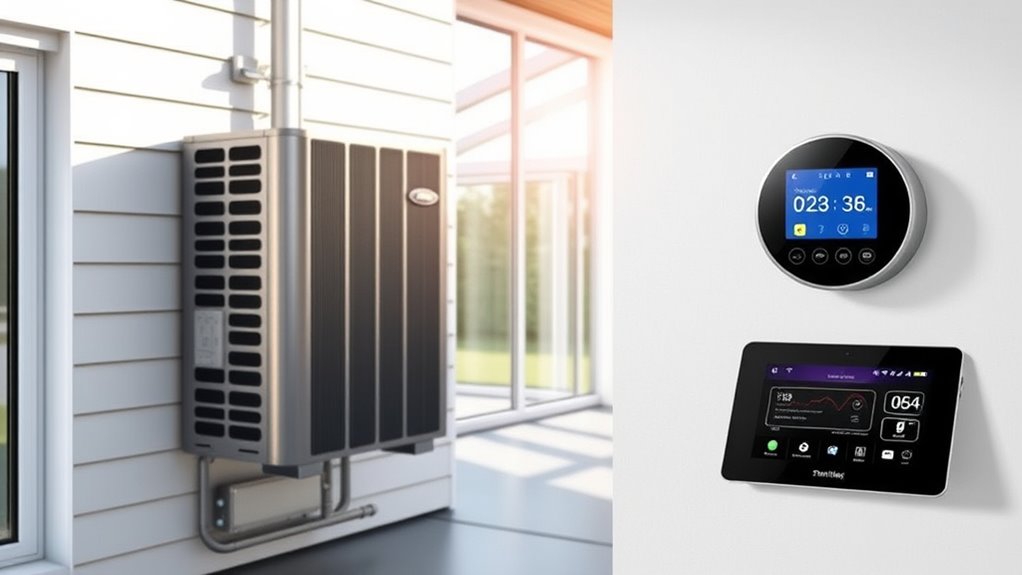
Setting up your smart heat pump system starts with choosing a compatible thermostat like Nest or Ecobee that works seamlessly with your device. Follow the installation instructions carefully, especially when wiring, and connect the thermostat to your Wi-Fi network using the app. Once installed, configure automation settings and test the system to guarantee it responds correctly to your remote adjustments. Additionally, ensure that your system supports smart home integration for optimal control and convenience. Practicing mindfulness during setup can help you stay focused and attentive to detail, reducing the risk of errors.
Choosing Compatible Devices
To successfully install and set up your smart heat pump system, it’s vital to choose compatible devices that work seamlessly together. Start by ensuring your smart thermostat supports your heat pump’s compatibility and device protocols like Wi-Fi, Zigbee, or Z-Wave for smooth heat pump integration. Check that your HVAC wiring, including a C-wire if necessary, is suitable for the smart thermostat to maintain reliable connectivity. Review manufacturer installation guides carefully or hire a professional HVAC technician for ideal setup. Use the mobile app to connect your smart thermostat to your home Wi-Fi network, enabling automation and remote control. Configuring automation rules, scheduling, and zone controls through the app will maximize energy efficiency and comfort tailored to your household needs. Understanding industry trends can help in selecting the most compatible and future-proof devices.
Proper Installation Steps
Beginning your proper installation involves selecting a compatible smart thermostat that supports your heat pump’s protocols, such as Wi-Fi, Zigbee, or Z-Wave. Turn off power to your heat pump and carefully remove the existing thermostat, noting the wiring connections for reference. During installation, connect the smart thermostat’s wires to the corresponding terminals, following the manufacturer’s instructions to guarantee proper system wiring for heating, cooling, and power. Once wired correctly, restore power and configure the thermostat via its app, connecting it to your Wi-Fi network. Set up your schedule and enable remote access to control your climate from anywhere. Verify that the system responds accurately, assuring smooth smart device integration and reliable climate control within your smart home.
Configuring Automation Settings
Once your smart heat pump system is installed and connected to Wi-Fi, the next step is to configure its automation settings to enhance comfort and energy efficiency. You’ll need to program schedules based on your daily routine, occupancy, and weather forecasts to improve system performance. Proper configuration involves setting sensors for temperature and occupancy, enabling automatic adjustments and zone control. Regularly updating firmware ensures your system stays current with the latest features and security. Adjust automation parameters seasonally to maximize energy savings and comfort. Consider integrating voice commands with platforms like Alexa or Google Assistant for hands-free control. Effective automation setup uses a combination of these strategies to achieve seamless climate regulation and energy optimization.
- Tailor schedules to occupancy and weather patterns
- Regularly update firmware for peak performance
- Adjust automation settings seasonally for efficiency
Integrating Sensors and Automation for Optimal Performance

Integrating sensors and automation transforms heat pump systems into highly responsive and efficient climate control solutions. By using sensors like occupancy detectors and temperature sensors, you provide real-time data that allows your smart home system to adjust heat pump operation automatically. System integration enables automated routines that activate sensors at specific times or conditions, ensuring ideal comfort and energy efficiency. Occupancy detection directs conditioned air only to occupied areas, reducing waste by up to 30%. AI algorithms analyze sensor data to predict heating and cooling needs, further enhancing system performance and lifespan. Accurate sensor placement and calibration are essential for reliable data collection, which directly improves automation efficiency and helps you achieve smarter, more sustainable climate control in your home.
Enhancing Energy Efficiency and Cost Savings

By leveraging smart control systems and sensor data, you can substantially boost your heat pump’s energy efficiency and reduce operating costs. Smart heat pumps integrated with smart thermostats enable precise zone control, targeting heating or cooling only where needed. Automated scheduling and remote access let you pre-condition your home efficiently, avoiding unnecessary energy use when you’re away or asleep. Environmental sensors combined with AI-driven algorithms proactively adjust operation based on weather conditions and occupancy patterns. This results in optimized performance and significant cost savings.
- Fine-tune your climate with zone control for maximum efficiency
- Use automated scheduling to reduce waste during unoccupied periods
- Rely on environmental sensors and AI to adapt to changing conditions effortlessly
Ensuring Security and Privacy in Smart Climate Systems

As smart climate systems become more common, safeguarding your home from cyber threats is essential. You need to prioritize cybersecurity and data privacy by using secure Wi-Fi connections, strong passwords, and regular firmware updates. Implementing multi-factor authentication and network segmentation helps prevent unauthorized access to your heat pump and related devices. Always review the data privacy policies of your smart device manufacturers to guarantee your personal information is protected. Disabling remote access features when not needed reduces vulnerabilities, while monitoring for unusual activity can alert you to potential breaches. Incorporating cybersecurity tools like firewalls further enhances system security. Staying vigilant about system vulnerabilities ensures your smart climate system remains safe from hacking attempts and unauthorized data collection.
Monitoring and Maintaining Your Smart Heat Pump System
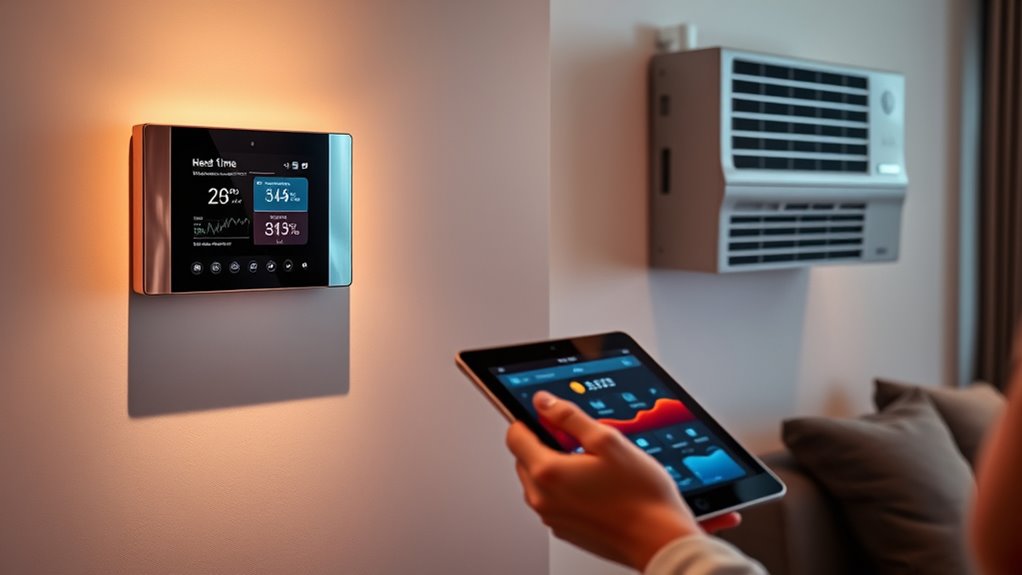
Regularly monitoring your smart heat pump system guarantees it runs efficiently and reliably. Use your smart app to review energy usage reports, pinpoint inefficiencies, and fine-tune performance. Keep an eye on maintenance alerts to address filter replacements, refrigerant checks, and other routine tasks that sustain peak energy efficiency. Leverage diagnostic tools and alerts within your system to monitor health and catch problems early. Don’t forget to update firmware promptly, as these updates enhance performance and security. Additionally, verify sensor calibration and placement to ensure accurate temperature readings and ideal control. Remember, consistent system monitoring and maintenance help you achieve maximum efficiency and extend your heat pump’s lifespan.
- Optimize system performance through regular diagnostics
- Maintain energy efficiency with timely updates
- Prevent issues by monitoring system health consistently
Future Trends in Smart Heat Pump Technology
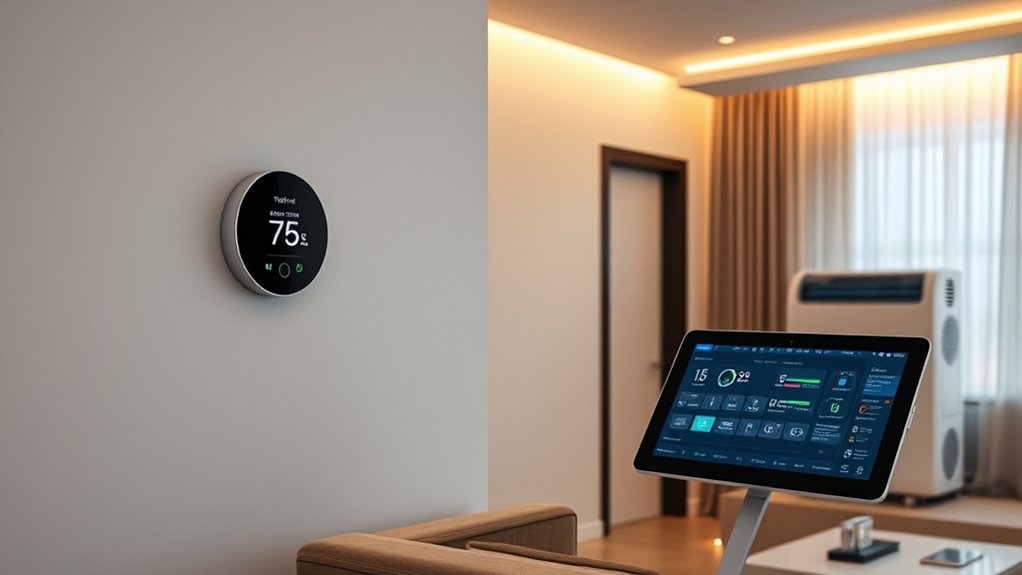
Future smart heat pump technology is poised to revolutionize home climate control through advanced AI algorithms that optimize performance based on real-time occupancy and weather data, potentially boosting energy efficiency by up to 40%. These smart heat pumps will seamlessly integrate with IoT devices, enabling predictive maintenance and remote troubleshooting that cut repair costs by 25%. Enhanced compatibility with voice assistants like Alexa, Google, and Apple HomeKit will allow effortless control within smart home automation systems. Developments in sensor technology will enable precise zoning and airflow management, reducing energy waste by 15-20%. Additionally, adaptive learning capabilities will personalize climate settings over time, increasing user satisfaction and further improving energy efficiency. These innovations will make smart heat pumps more intuitive, efficient, and integrated into future home automation.
Frequently Asked Questions
Do Heat Pumps Work With Smart Thermostats?
Yes, heat pumps do work with smart thermostats. You can control your heat pump remotely, set schedules, and optimize energy use. Just guarantee your heat pump is compatible, and you might need a C-wire for power. Professional installation is recommended to connect everything correctly. Once set up, you’ll enjoy more convenience, better efficiency, and the ability to monitor your system’s performance from anywhere.
Do Programmable Thermostats Work With Heat Pumps?
Yes, programmable thermostats work with heat pumps. They allow you to schedule heating and cooling automatically, optimizing comfort and efficiency. Many modern models are designed specifically for heat pumps, supporting their unique modes. Just make sure to double-check your thermostat’s wiring and features—especially auxiliary heat control—to guarantee compatibility with your heat pump. Verifying this before installation helps you get the most out of your system.
What Is the Major Disadvantage of a Heat Pump System?
The major disadvantage of a heat pump system is its reduced efficiency in extremely cold climates. When temperatures drop below freezing, your heat pump struggles to extract enough heat, leading to higher energy use and costs. You might find yourself relying on supplemental heating, which increases expenses and complexity. Plus, installation and maintenance can be more challenging due to issues like defrosting and refrigerant leaks.
Why Is My Heat Pump Not Responding to My Thermostat?
They say “a chain is only as strong as its weakest link,” and that’s true for your heat pump. If it’s not responding, check your thermostat’s wiring—loose or faulty connections can be to blame. Make sure the circuit breaker hasn’t tripped, and ensure your firmware is up to date. Also, verify sensor functioning, because a malfunctioning sensor can prevent the system from responding properly.
Conclusion
By integrating heat pumps with smart home climate systems, you can enjoy greater comfort, energy savings, and convenience. With the right setup, automation, and security, your home becomes more efficient and responsive to your needs. Are you ready to embrace this smart, eco-friendly future? Taking the step now not only benefits your wallet but also helps protect the environment. Isn’t it time you made your home smarter and greener?
